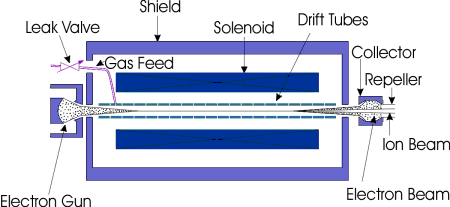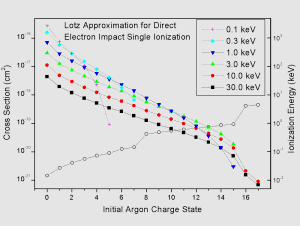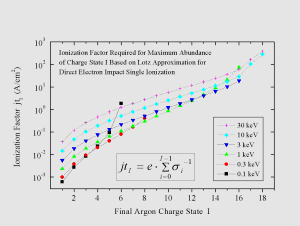
 |
| A cross-sectional view of CRYEBIS |
|---|
|
The KSU-CRYEBIS, a CRYogenic Electron Beam Ion Source,
produces highly charged ions with an electron beam which
strips many or even all electrons from atoms which happen to
cross its path. Observing the ion production yields allows
us to investigate many interesting features of electron
impact ionization processes as well as features of
electronic recombination processes.
The electron beam emerges from the hot spherical cathode of the electron gun. The gun focuses the electrons down to a 1 mm spot size at the entrance of the superconducting solenoid. The electrons tend to follow the magnetic field lines and therefore the 3-5 Tesla solenoidal field compresses the electron beam to a diameter of less than 0.1 mm, producing electron beam densities of many hundreds of amps per square centimeter. The electron beam expands as it leaves the solenoid, where it is absorbed by the collector.
As electrons are removed, the remaining electrons are more strongly bound to the ion and therefore require more energetic electrons, or closer hits, to be removed. The binding, or ionization, energy of the remaining electron is the minimum energy required for its removal. It represents a threshold which becomes visible when, for example, one tries to remove the inner-most electrons from Argon, which have a binding energy of 4.12 keV for Ar16+ and 4.43 keV for Ar17+. Probing Ionization Thresholds allows one to observe the production of Ar17+ once the electron energy is raised above the 4.12 keV threshold, which cannot be observed below the threshold, even with excessively long confinement times. The electron energy in the main trap can be determined by adding the electron gun cathode voltage to the selected main trap voltage. The most comprehensive picture of the sequential electron impact ionization of ions can be obtained by studying the Evolution of Charge States, where the computer automatically measures a series of charge state distributions for a range of confinement times and plots the populations of the different charge states versus confinement time. This allows one to watch the lower charge states fade away as the ongoing ionization process converts them to higher charge states. The electron impact causes the ions to lose their electrons, at least in most cases. Less likely, but also possible, is the reverse process where the ions capture an electron from the electron beam. The momentum, or velocity, mismatch makes direct (or radiative) capture very unlikely. More likely is dielectronic capture where an energetic beam electron interacts with an electron of the ion. The electron from the ion is promoted to an excited state, while the beam electron loses enough energy to be captured into a bound level. As all levels have very specific energies, this process is resonant and can only be observed at very specific electron beam energies. The process is less likely than ionization but becomes obvious when observing terminal charge state distributions, which are charge state distributions of ions that have reached their equilibrium after a long bombardment. The Dielectronic Recombination experiment allows one to ionize Ar ions with an electron beam energy between 2 and 4 keV. This is below the ionization threshold of Ar16+ which will become the dominant charge state after a long confinement time. A small fraction of Ar15+ can always be observed due to capture of electrons from the residual gas. However, whenever the electron beam energy matches a dielectronic resonance, the dielectronic capture dramatically boosts the capture rate. This enhances the Ar15+ population while depleting the Ar16+ population. One can watch for the dramatic changes in the Ar15+ and Ar16+ populations while the computer scans the electron beam energy. |


